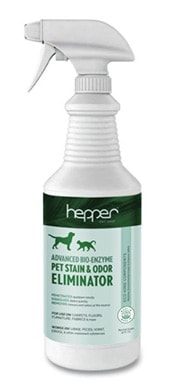How to Get Cat Poop Stains and Smells Out of a Couch: 8 Potential Methods
-
Chantelle Fowler
- Last updated:
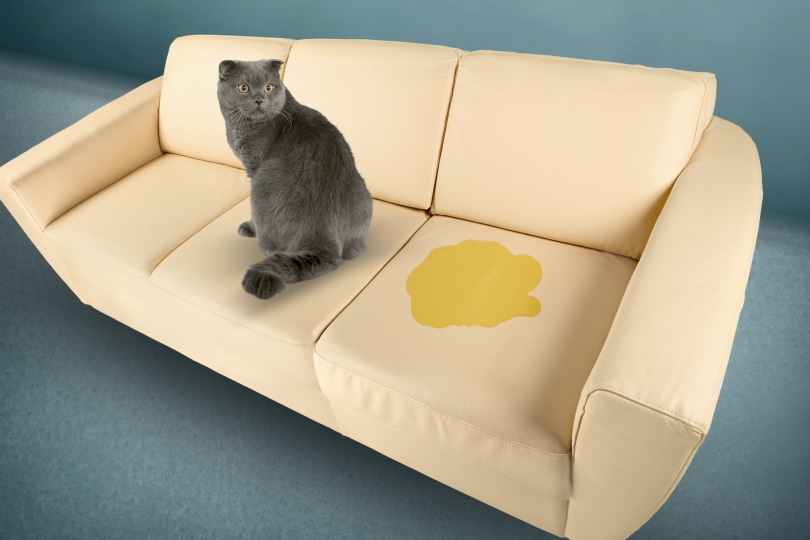
Did your cat leave an unpleasant surprise on your living room furniture? A poop or urine stain can not only ruin the sofa, but the scent can envelop your entire home. You might be tempted to take your soiled sofa to the dump, but don’t go that route just yet.
While there may be an underlying cause for soiling outside the litter box, even the most well-behaved cats have accidents sometimes. If you’ve found that your cat has mistaken your couch for their litter box, don’t fret. Keep reading to find several methods you can use to remove both the stain and odor.
Before You Start
It’s easy to launder soiled bed linens or articles of clothing, but furniture upholstery requires care and special attention. Certain fabrics need gentle detergents to prevent further damage or discoloration. Consult the furniture manufacturer before using any chemical or homemade cleaners on your couch.
You can also check your couch’s cleaning tag for reference codes. The tags are often located under the cushion or in small crevices. Familiarize yourself with the codes to determine which cleaners you can safely use without destroying your couch.
How to Get Cat Poop Stains and Smells Out of a Couch
1. Act Fast
Time is of the essence when it comes to accidents outside the litter box. The scent of pet waste is strong, so the faster you remove it, the less time it’ll have to soak into your couch’s upholstery.
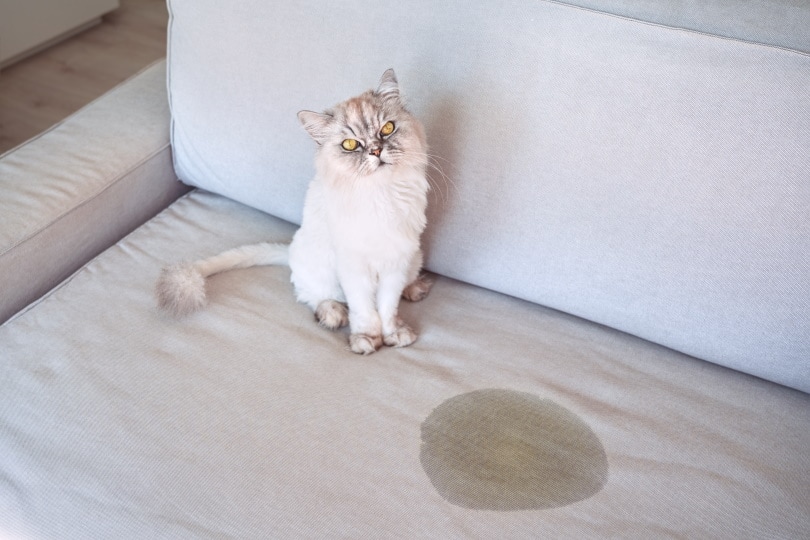
2. Remove the Waste
A paper towel or plastic bag wrapped around your hand works great for picking up excrement. Always wear gloves when handling cat poop. It may contain a parasite that causes toxoplasmosis—a disease that can cause flu-like symptoms.
If the poop has been present for some time, it may have started to harden. A vacuum can remove any pieces of feces that have had the chance to harden. If your cat has pooped in a crease of the sofa, use the attachment for your vacuum to get into the crevice.
If the poop is diarrhea consistency, avoid grinding it into the fabrics of your sofa. The potent scent can become permanent if you rub at the stain too hard, and it gets into the fibers of your sofa fabric. Instead, sprinkle baking soda over the soiled area and allow it to sit for an hour. The poop will dry up after an hour, and you can then scrape off or vacuum the remaining mess.

3. Use an Enzyme Cleaner
An enzyme cleaner is a cat owner’s best friend. These cleaners are effective at removing odors and are non-toxic, so they’re safe to use. It’s important to ensure you’re removing any offensive pet smells like feces or urine entirely.
Cats will repeatedly soil the same spots if they can smell the faintest remnant of their previous accident. An enzymatic cleaner ensures the scent is fully removed, so there won’t be any further accidents in that spot.
Are you looking for an enzyme cleaner that can keep your house clean and your pet happy? We recommend the Hepper Advanced Bio-Enzyme Pet Stain & Odor Eliminator Spray, which permanently gets rid of the most stubborn stains and smells. There’s even a 100% satisfaction guarantee so you can try this cleaner risk-free! Click here to order your first bottle.
At House Grail, we’ve admired Hepper for many years, and decided to take a controlling ownership interest so that we could benefit from the outstanding products of this cool cat company!
Enzyme cleaners come in spray bottles and jugs. The sprays are perfect for cleaning messes on floors or upholstery. The jugs are great if your pet often pees or poops on your clothing. You can add a little of the solution to your laundry to remove the offensive odor.
Follow the instructions on the bottle for the best results.
4. Use Dish Soap
Once the bulk of the waste is removed with a paper towel or cloth, mix ½ tablespoon of Dawn dishwashing liquid with 1 tablespoon of white vinegar into 2 cups of hot water.
Use a clean cloth to blot the stain with your cleaning solution until the liquid is absorbed. Keep applying your homemade cleaner and gently blotting the stain until it disappears.
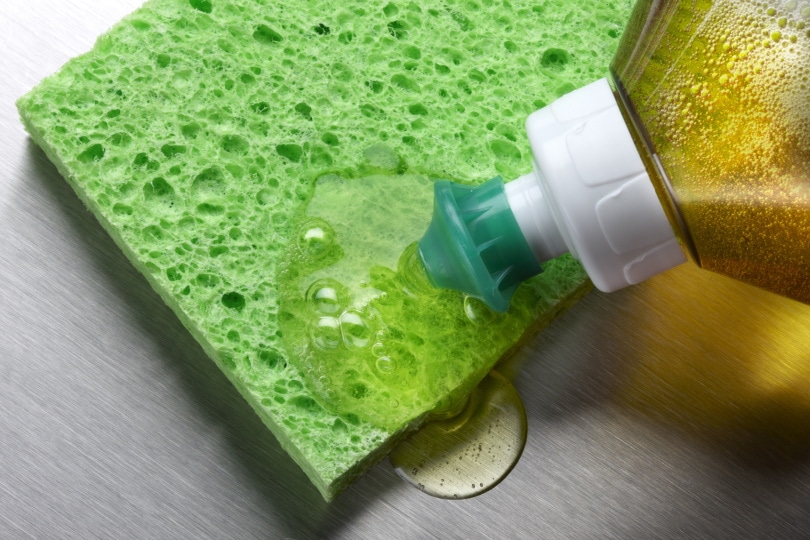
5. Try Baking Soda and Vinegar
If you have a fabric couch, try covering the stain with baking soda once you remove the poop. Allow the baking soda to sit for 10 minutes before vacuuming it off.
Next, mix equal parts warm water and vinegar in a spray bottle. Before screwing the lid back onto the bottle, add 1 tablespoon of baking soda. Remember that baking soda and vinegar will have a chemical reaction, so put the top back onto the bottle before it bubbles out of the sprayer. Spray the cloth with your cleaning solution and gently dab it onto the stain.
If you’re dealing with a stubborn stain, follow up this technique with peroxide. Use an eyedropper or pipette to drop a few drops of hydrogen peroxide. Peroxide is a mild bleach, so we recommend testing a drop or two on a small, inconspicuous area of your sofa to avoid any adverse reactions and further staining.
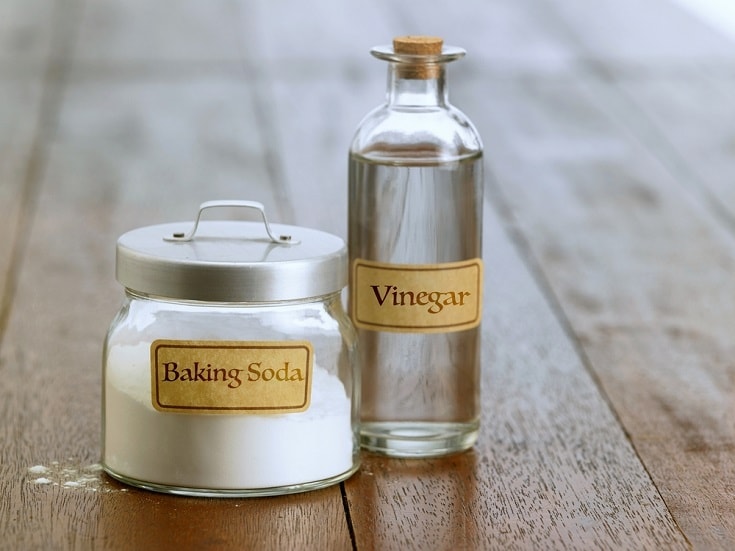
6. Use Rubbing Alcohol
Rubbing alcohol will be your best friend if your couch is made with a microfiber material. Put rubbing alcohol into a spray bottle and spritz the soiled area. Scrub the stain with a white sponge to ensure no color from the sponge runs onto your sofa.
Once the area is dry, use a scrub brush in a circular motion to re-fluff the microfiber fabric.
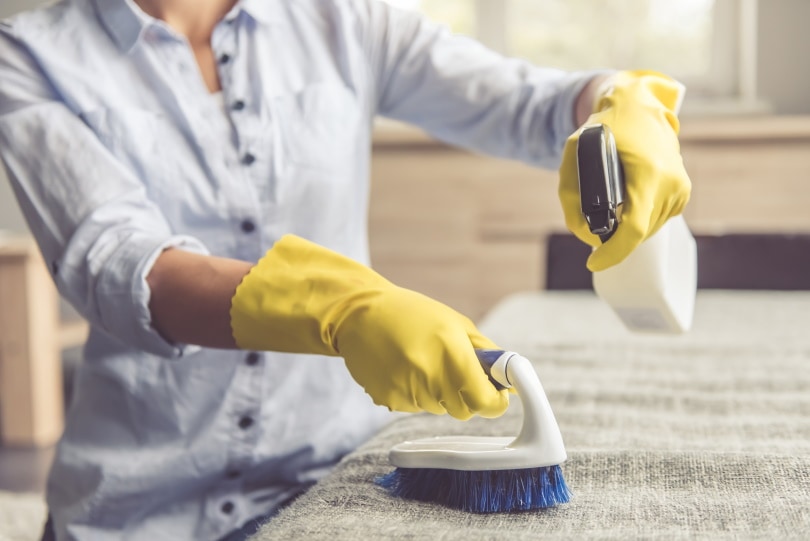
7. Use a Fabric Deodorizer
Once the stain has been removed, the next step is to make your couch smell good again. A pet-friendly fabric deodorizer will neutralize any remaining scents to ensure your cat isn’t tempted to soil the same spot again.
There are plenty of great-smelling fabric-specific deodorizers on the market. You may find that citrus or lavender-scented options will successfully deter future accidents.
You can also use baking soda to help neutralize odors. Leave it on your sofa overnight and then vacuum it in the morning. You may need to repeat this step a few times before the odor is entirely removed.
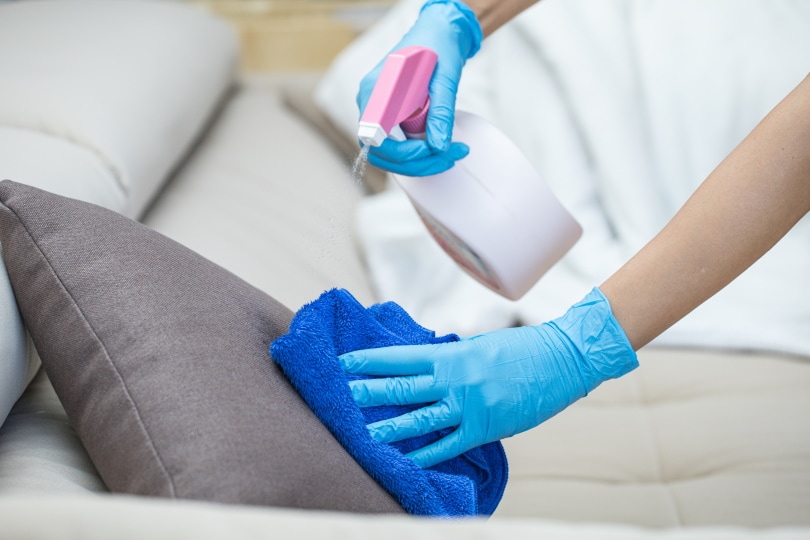
8. Consider Covering the Couch
Your cat might continue to poop on your furniture even if you’ve removed the scent and ensured there’s nothing physically wrong with them. If that is the case with your cat, you might consider covering your couch with a removable cover, blankets, or a sheet.
This method may take away from the beauty of your sofa, but it will protect it in the long run. You can find couch covers online that are not only easy to use but nice to look at, too.

Conclusion: Remove Cat Poop Stain From Couch
A soiled sofa doesn’t spell a death sentence for your couch. With patience and elbow grease, your couch can look and smell brand new again. If your cat continues to make messes outside the litter box, you may need to make an appointment with your veterinarian. There are many reasons your cat isn’t using their litter box, so it’s worth getting them checked out for your peace of mind.
Keep browsing our website for more tips and tricks for helping you and your cat live harmoniously.
Featured Image Credit: Billion Photos, Shutterstock
Contents

